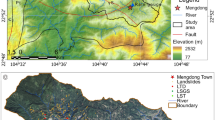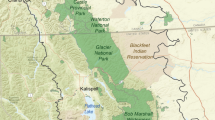Abstract
Emerging as an important issue in the disciplines of landscape ecology and landscape hydrology which inspired it, defining the concept of landscape metrics in a hydrological context has become a challenge to both landscape planners and engineers. Accordingly, the present study addresses the relationships existing between flooding phenomena and landscape metrics (shape index, fractal dimension index, perimeter-area ratio, related circumscribing circle, and contiguity index) of land use/land cover, hydrological soil groups and geological permeability classes. A regionalization approach was adopted employing 39 select catchments (33—4800 km2 in area, 0.47—21 m3 s−1 in mean discharge), located within the southern basin of the Caspian Sea. These catchments were predominantly covered by forest (57.4%), while rangeland, farmland and urban areas accounted for 25.9%, 11.7%, and 1.6%, respectively. Class-level landscape structural metrics of land use/land cover, hydrological soil groups and geological permeability classes have then been served as inputs to stepwise multiple linear regression analysis in an attempt to explain the flood magnitudes. The regression models (0.69 ≤ r2 ≤ 0.84) suggested that the catchments’ flood magnitude could explicitly be predicted using average measure of the shape and related circumscribing circle indices for the land use/land cover classes and those of hydrologic soil groups and geological permeability classes of the catchments. This indicated that regularity (vs. irregularity) of the landscape, pedoscape, and lithoscape, as represented by the shape index as well as the circumscribing circle index (for elongation and convolution), explained 69–84% of the variation in the flood magnitudes in the catchment.


Similar content being viewed by others
References
Ahearn DS, Sheibley RW, Dahlgren RA, Anderson M, Johnson J, Tate KW (2005) Land use and land cover influence on water quality in the last free-flowing river draining the western Sierra Nevada, California. J Hydrol 313(3-4):234–247
Alila Y, Kuraś PK, Schnorbus M, Hudson R (2009) Forests and floods: A new paradigm sheds light on age-old controversies. Water Resour Res 45(8):W08416
Amatya DM, Douglas-Mankin KR, Williams TM, Skaggs RW, Nettles JE (2011) Advances in forest hydrology: Challenges and opportunities. Trans ASABE 54(6):2049–2056
Amiri BJ, Fohrer N, Cullmann J, Hörmann G, Müller F, Adamowski J (2016) Regionalization of Tank Model Using Landscape Metrics of Catchments. Water Resour Manag 30(14):5065–5085
Amiri BJ, Nakane K (2008) Entire catchment and buffer zone approach to modeling linkage between river water quality and land cover—a case study of Yamaguchi Prefecture, Japan. Chin Geogr Sci 18(1):85–92
Amiri BJ, Nakane K (2009) Modeling the linkage between river water quality and landscape metrics in the Chugoku district of Japan. J Water Resour Manag 23:931–956
Baker WL, Cai Y (1992) The programs for multiscale analysis of landscape structure using the GRASS geographical information system. Landsc Ecol 7:291–302
Bathurst JC, Iroumé A, Cisneros F, Fallas J, Iturraspe R, Novillo MG, Urciuolo A et al (2011) Forest impact on floods due to extreme rainfall and snowmelt in four Latin American environments 1: Field data analysis. J Hydrol 400(3):281–291
Burn DH, Goel NK (2001) Flood Frequency Analysis for the Red River at Winnipeg, Canadian J. Engineering 28:355–362
Chatterjee S, Hadi AS, Price B (2000) The Use of Regression Analysis by Example. John Wiley and Sons, New York
Dohner E, Markowitz A, Barbour M, Simpson J, Byrne J, Dates G (1997) Volunteer stream monitoring: a methods manual environmental protection agency: office of water (EPA 841-B-97-003). Environmental Protection Agency: Office of Water and Washington, DC
Farina A (2000) Principles and Methods in Landscape Ecology, Kluwer Academic Publisher, The Netherlands, pp 154–155
Fatehi I, Amiri BJ, Alizadeh A, Adamowski J (2015) Modeling the Relationship between Catchment Attributes and In-stream Water Quality. Water Resour Manag 29(14):5055–5072
Forman RTT, Godron M (1986) Landscape Ecology. Wiley, New York
Gholami V, Asghari A, Taghvaye Salimi E (2016) Flood hazard zoning using geographic information system (GIS) and HEC-RAS model (Case study: Rasht City). Caspian Journal of Environmental Sciences 14(3):263–272
Griffith J (2002) Geographic techniques and recent applications of remote sensing to landscape-water quality studies. Water Air Soil Pollut 138:181–197
Gustafson EJ (1998) Quantifying landscape spatial pattern: what is the state of the art?. Ecosystems 1(2):143–156
He HS, DeZonia BE, Mladenoff DJ (2000) An aggregation index (AI) to quantify spatial patterns of landscapes. Landsc Ecol 15:591–601
ISC (2012) Iran statistical yearbook. Iran Statistical Center, Tehran
Jaeger JAG (2000) Landscape division, splitting index, and effective mesh size: new measures of landscape fragmentation. Landsc Ecol 15:115–130
Jones JA, Grant GE (1996) Peak flow responses to clear-cutting and roads in small and large basins, western Cascades, Oregon. Water Resour Res 32(4):959–974
Kearns FR, Maggi KN, Carter JL, Resh VH (2005) A method for the use of landscape metrics in freshwater research and management. Landsc Ecol 20:113–125
Kim JK (2005) Exploring the effects of local development regulations on ecological landscape structure. Ph.D. thesis, Texas A&M University, p 184, Seen 27 February 2013 at http://repository.tamu.edu//handle/1969.1/2403
Li H, Reynolds JF (1995) On definition and quantification of heterogeneity. Oikos 73:280–284
Mahdavi M, Osati K, Sadeghi SAN, Karimi B, Mobaraki J (2010) Determining suitable probability distribution models for annual precipitation data (a case study of Mazandaran and Golestan provinces). Journal of Sustainable Development 3(1):159
McGarigal K, Cushman SA, Neel MC, Ene E (2002) FRAGSTATS: spatial pattern analysis program for categorical maps. Computer software program produced by the authors at the University of Massachusetts, Amherst, available at the following web site: http://www.umass.edu/landeco/research/fragstats/fragstats.html
McGarigal K, Marks BJ (1995) FRAGSTATS: Spatial Analysis Program for Quantifying Landscape Structure. USDA Forest Service General Technical Report PNW-GTR-351, Gustafson, 1998
Merz R, Blöschl G (2005) Flood frequency regionalisation—spatial proximity vs. catchment attributes. J Hydrol 302(1):283–306
Moreno D, Pedrocchi C, Comin FA, Cabezas A (2007) Creating wetlands for the improvement of water quality and landscape restoration in semi-arid zones degraded by intensive agricultural use. Ecol Eng 30(2):103–111
Neter J, Kutner HM, Nachtsheim CJ, Wasserman W (1996) Applied Linear Statistical Models. Irwin, Chicago
Nied M, Hundecha Y, Merz B (2013) Flood-initiating catchment conditions: a spatio-temporal analysis of large-scale soil moisture patterns in the Elbe River basin. Hydrol Earth Syst Sci 17(4):1401–1414
O’Connell PE, Ewen J, O’Donnell G, Quinn P (2007) Is there a link between agricultural land-use management and flooding? Hydrol Earth Syst Sci 11(1):96–107
O’Neill RV, Krummel JR, Gardner RH, Sugihara G, Jackson B, DeAngelis DL, Milne BT, Turner MG, Zygmunt B, Christensen SW, Dale VH, Graham RL (1988) Indices of landscape pattern. Landsc Ecol 1:153–162
Pfaundler M (2001) Adapting, analysing and evaluating a flexible index flood regionalisation approach for heterogeneous geographical environments. Diss., Technische Wissenschaften ETH Zürich, Nr. 14253, https://doi.org/10.3929/ethz-a-004176052
Rutledge DT (2003) Landscape indices as measures of the effects of fragmentation: can pattern reflect process? Department of Conservation, Wellington
Sangani MH, Amiri BJ, Shabani AA, Sakieh Y, Ashrafi S (2015) Modeling relationships between catchment attributes and river water quality in southern catchments of the Caspian Sea. Environ Sci Pollut Res 22(7):4985–5002
Sikka AK, Samra JS, Sharda VN, Samraj P, Lakshmanan V (2003) Low flow and high flow responses to converting natural grassland into bluegum (Eucalyptus globulus) in Nilgiris catchments of South India. J Hydrol 270(1):12–26
Sliva L, Williams DD (2001) Buffer zone versus the whole catchment approaches to studying land use impact on river water quality. Water Res 35(14):3462–3472
Turner MG (1990) Spatial and temporal analysis of landscape patterns. Landsc Ecol 4:21–30
Turner MG, Gardner RH (1991) Quantitative Methods in Landscape Ecology. Springer-Verlag, New York
Turner MG, Gardner RH, O'neill RV (2001) Landscape ecology in theory and practice, vol 401. Springer, New York
Turner RE, Rabalais NN (2003) Linking Landscape and Water Quality in the Mississippi River Basin for 200 Years. Bioscience 53(6):563–572
Uhlenbrook S, Steinbrich A, Tetzlaff D, Leibundgut C (2002) Regional analysis of the generation of extreme floods. International Association of Hydrological Sciences, Cape Town, Publication 274:243–249
USDA (1986) Urban hydrology for small catchments, Technical Release 55 (TR-55) (Second ed.). Natural Resources Conservation Service, Conservation Engineering Division, Washington, DC
USGS (1982) Guidelines for determining flood flow frequency. Office of Water Data Coordination, Bulletin B, 17B, Virginia
Uuemaa E, Roosaare J, Mander U (2005) Scale dependence of landscape metrics and their indicatory value for nutrient and organic matter losses from catchments. Ecol Indic 5:350–369
Uuemmaa E, Roosaare J, Mander U (2007) Landscape metrics as indicators of river water quality at the catchment scale. Nord Hydrol 38(2):125–138
Wickham JD, Wade TG, Riitters KH, O’Neill RV, Smith JH, Smith ER, Jones KB, Uhlenbrook S, Steinbrich A, Tetzlaff D, Leibundgut C (2002) Regional analysis of the generation of extreme floods. International Association of Hydrological Sciences, Publication 274:243–249
Yazdani MR, Sheikh Z (2017) Applying geostatistical methods for analyzing regional flood frequency in North of Iran (Case Study: Mazandaran Catchments). J Agric Sci Technol 19:861–875
Acknowledgements
The first author (B.J.A.) acknowledges that the present study has financially been supported through visiting professor fellowship which has been awarded by Chinese Academy of Sciences (CAS) in Nanjing Institute of Geography and Limnology.
Author information
Authors and Affiliations
Corresponding author
Rights and permissions
About this article
Cite this article
Amiri, B.J., Junfeng, G., Fohrer, N. et al. Regionalizing Flood Magnitudes using Landscape Structural Patterns of Catchments. Water Resour Manage 32, 2385–2403 (2018). https://doi.org/10.1007/s11269-018-1935-3
Received:
Accepted:
Published:
Issue Date:
DOI: https://doi.org/10.1007/s11269-018-1935-3




